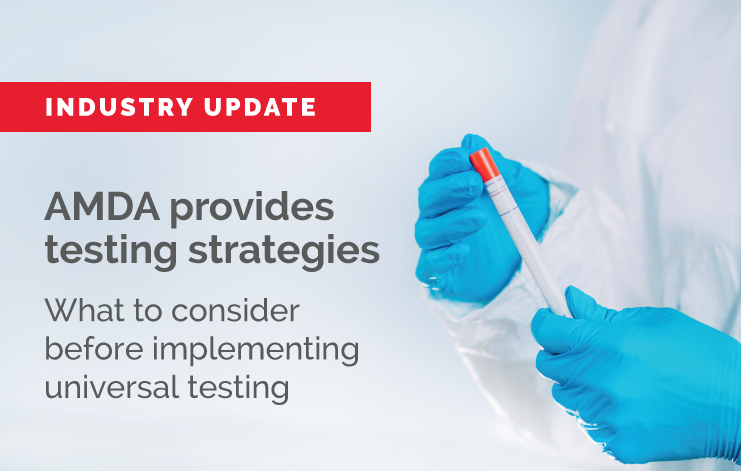UPDATE: New link for AMDA's Policy Statement on Universal Testing
The document's web address has been changed. The new URL can be located below.AMDA posted this document on May 18, 2020. Here is the issue that the document addresses:
“There is a clear understanding that protecting our vulnerable post-acute and long-term care (PALTC) population is dependent on adequate access to testing. Testing must be readily accessible, completed in a timely manner by those with appropriate training, have low false negative or false positive rates, impose a low physical or emotional burden on the person being tested, and be appropriately reimbursed.
Many states, local health departments, facilities, and consumers are calling for “universal testing” of PALTC residents and staff. The underlying premises behind these calls are that tests would be available for all, would meet the criteria set forth above, result in better care being delivered to our PALTC residents, and save lives.
A number of considerations must be addressed before implementing universal testing.”
- What is meant by universal testing?
- How often must universal testing be done?
- What is the turnaround time for testing?
- Should healthcare personnel, residents, or both be tested?
- What tests should be used?
- Can facilities cover the costs of testing?
- Are HCP tests covered by private healthcare insurance?
- Is there coverage for more than one test?
- Do we have enough tests?
- What happens if large numbers of staff must suddenly be furloughed?
- Is there a plan in place to deal with the test results?
- What if HCP or residents are resistant to testing?
- What is the emotional impact of repeated testing of residents with dementia, anxiety, post-traumatic stress disorders or other psychological health conditions?
- Prevalence matters.
- Should nursing facilities and assisted living communities be treated similarly?
- Testing alone is not enough.
You’ll appreciate the considerations offered by AMDA for each of the above issues.
“Increasingly, states are issuing orders for nursing homes and assisted living communities to conduct universal testing of all staff and/or residents. While such mandates are well-intentioned, they do not account for all, if any, of the considerations outlined above. Generally, this is because PALTC expertise and situational understanding have not been included when such policies are being developed. Testing decisions must be individualized to the facility with a clear understanding of the regional prevalence of disease, local testing accessibility and capacity, and well-defined goals of testing.
Without making sure that all complexities related to testing are addressed, in consultation with PALTC medical and clinical specialists, such mandates are likely to be counterproductive and will not produce the results they were intended to deliver.”
Please share this 3-page document with your team which includes your Medical Director! This is a very thoughtful document that should guide LTC/Senior Living decisions going forward.
A huge thank-you to AMDA for all you do for us!
Want to keep up with the changing COVID-19 situation in skilled nursing?





2 Comments on “AMDA considerations to consider before implementing universal testing”
Greetings:
I am having difficulty finding the link to “this 3 page document”. Where might I find it?
Thank You,
Mary
Hi Mary, the document can be found here. Thanks!